This Simple Sourdough Bread is just that…simple! It is made using my homemade sourdough starter that is just as easy! So, after your sourdough starter is ready to go, be sure to make this crusty and chewy (in the best way) bread. This bread is certainly delicious on its own, but use it for my Crispy Cheese Sandwich or Apple Gouda Grilled Cheese next time to really make the sandwiches stand out!
Simple Sourdough Bread
Sourdough bread is one of those loaves of bread I always get from the bakery or in the bakery department at my local grocery store. It’s also my bread of choice (when it’s an option) at my favorite restaurants. There is just something special about the somewhat fermented taste of it. So, once I figured out the sourdough starter, I knew I had to use it for this simple sourdough bread!
Plus, there are never too many bread recipes to have at your fingertips, especially when we may be home more than normal!
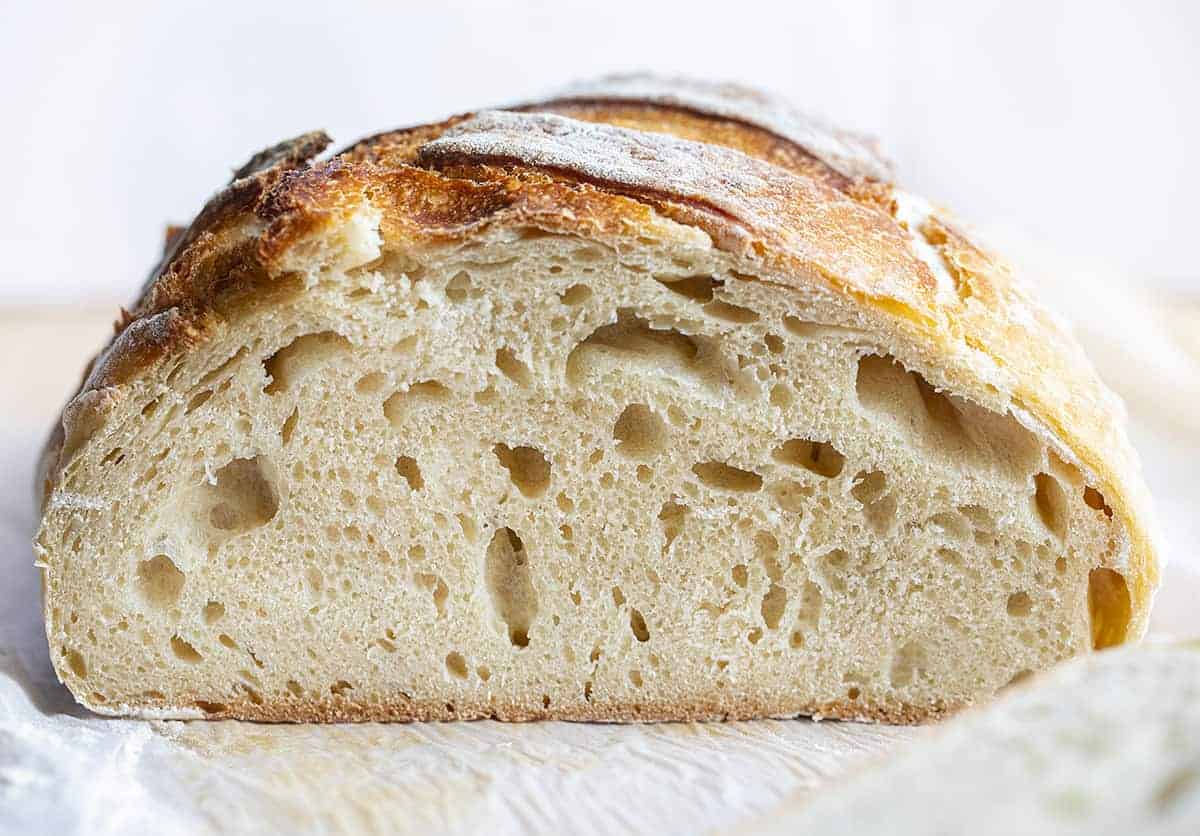
Simple Sourdough Bread Recipe
This Simple Sourdough Bread recipe takes a little patience to let the dough rise a couple of times before baking it. But, if you were patient enough to get your sourdough starter ready to go, then a few hours is nothing! Plus, it is SO worth it to have freshly baked bread! There are only five ingredients to this recipe, so you more than likely have everything you need on hand.
How to Make Simple Sourdough Bread
Get out your stand mixer (or get your muscles ready) to mix the ingredients for the dough.
- Combine all the ingredients together in the bowl from your stand mixer. (Learn how to make a Sourdough Starter here)
- Use the dough hook attachment and mix the ingredients together on medium-low speed (or no higher than a ‘2’ setting). If you are mixing by hand, knead everything together for about ten minutes.
- After you have mixed the dough (it will be sticky), place it in a lightly oiled bowl.
- Cover the dough with plastic and let it sit for about 3 hours to let it rise.
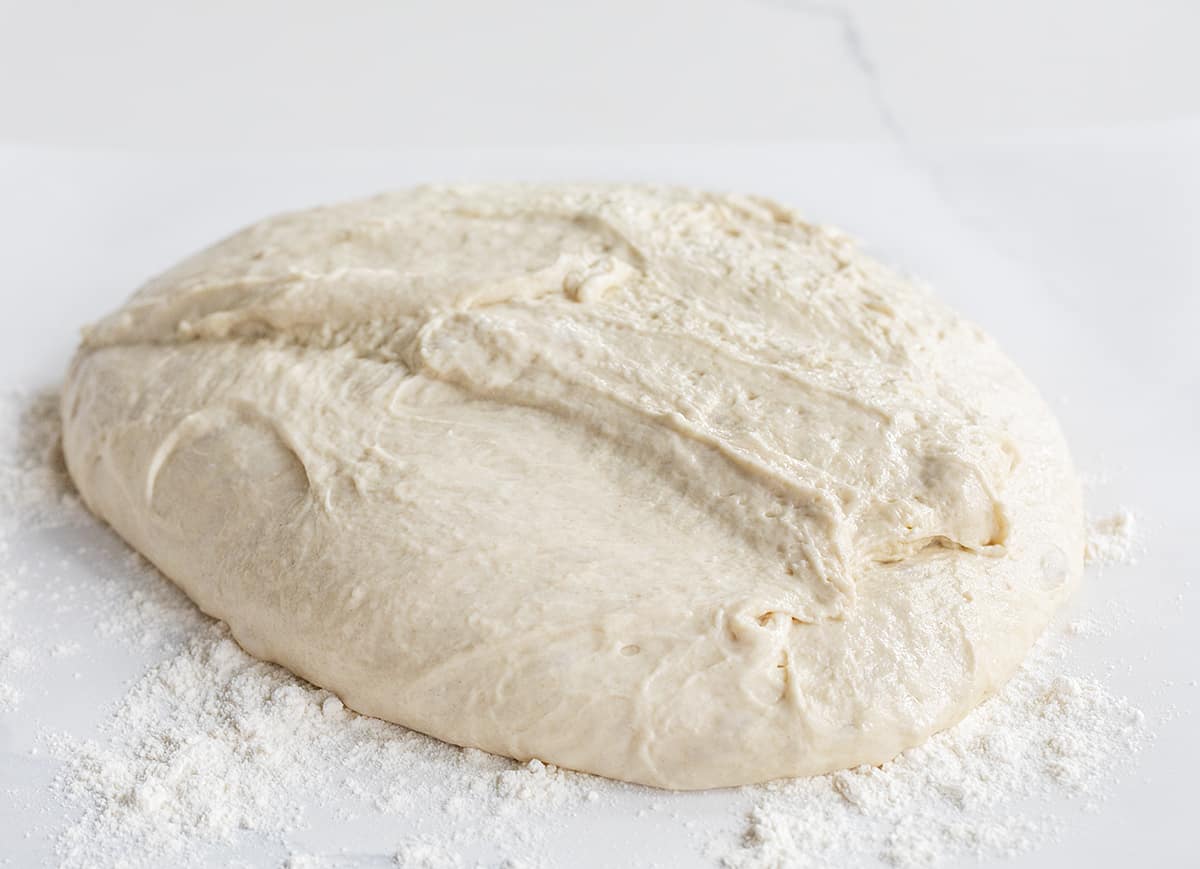
After the dough has had time to rise, gently fold up the sides of the dough, rotate the bowl, and fold again. Continue to do this until you have folded and rotated the dough a few times.
Did you know that using your hands this way and baking bread, in general, is very therapeutic? It involves patience and it can be very calming. Speaking of patience, after folding and rotating the dough, you need to cover it again to let it rise. It may not take the full 3 hours this time; it depends on how warm your kitchen is. Check it after a couple of hours.
After a couple of hours, sprinkle some flour onto your work surface and place the dough on the flour. Pull up the sides of the dough, pressing them into the center. You may need more flour, so keep that nearby! Continue to pull and press for a while. Finally, flip over the dough. The top should be smooth. Sprinkle some flour on it, and place it on a piece of parchment paper.
Once the dough is on the parchment paper, score the dough, or make a few cuts on the top of the dough a few times with a knife.
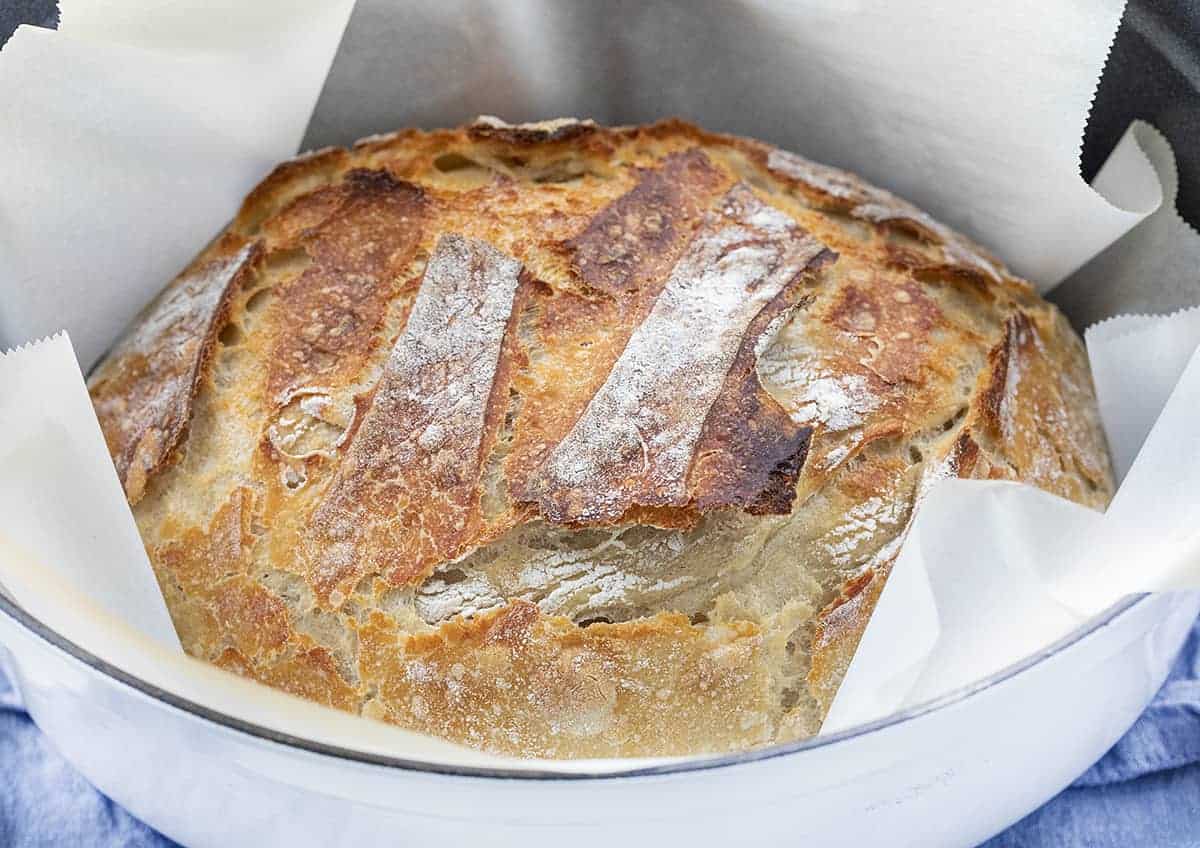
How to Bake Simple Sourdough Bread
Once the dough is on the parchment paper (or you could do this before you pull and press the dough the final time), put a Dutch oven–lid ON–into a cold oven. Set the oven to 450°F to heat up the Dutch oven. Once the oven has reached the temperature of 450°F, carefully remove the hot Dutch oven and take off the lid (setting the lid on the stovetop).
Grab the parchment paper that is holding the dough and place it (again, carefully) into the hot Dutch oven. Cover it, and bake the bread for 15 minutes, with the oven still set at 450°F. After fifteen minutes, remove the lid of the Dutch oven and bake for an additional 10-15 minutes, or until the top is a nice golden brown.
When you tap on the top of the bread, you should hear a hollow sound. Then, you know it is ready to be taken out of the oven. Let it sit for about 20 minutes on the counter or stovetop before taking it out of the Dutch oven and sliced. Enjoy!
How to Store Simple Sourdough Bread
Sourdough bread usually lasts for 4-5 days at room temperature. Do not store it in the refrigerator. Instead, keep it covered with a towel or in a zipped plastic bag someplace that is relatively cool. A bread box also works well. If you want to freeze the bread, be sure to let the bread cool completely before freezing!
The same advice goes for when you are going to cut into the bread–wait until it has cooled. Anyway, to freeze the bread, seal the loaf into a zipped plastic freezer bag, making sure to let all the air out. You can store bread for up to 6 months in the freezer, but the longer you keep it in there, the less fresh tasting it will be. (And be sure to label it with the date!)
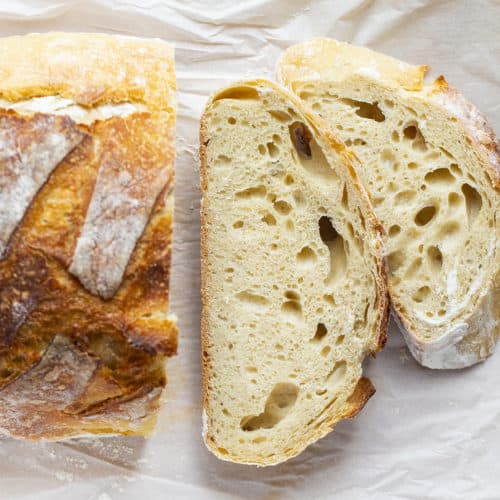
Simple Sourdough Bread
Ingredients
- 4-5 cups (500-625g) all-purpose flour, I prefer unbleached
- 1 1/2 cups (355g) warm water
- 3/4 cup (170g) active sourdough starter
- 1 tablespoon honey
- 1 teaspoon salt
Instructions
- Add all ingredients together in the bowl of a stand mixer with dough hook.
- Turn the mixer on 1-2 (never higher than 2 or medium-low) and let the mixer knead the dough for about 5 minutes. The dough will be sticky and doesn’t quite form a ball. (If making by hand, knead for about 10 minutes.)
- Turn off the mixer and scrape the dough into a medium bowl that has been lightly coated with oil. Cover with plastic and set aside for about 3 hours while the dough rises.
- After 3 hours, turn the dough and gently start folding up the sides. Grab the dough at the side of the bowl and lift up and towards the center of the bowl. Press down, turn the bowl 90 degrees and repeat this several times.
- Cover again and let it rise for an additional 2-3 hours. (This will depend on the temperature of your home. A warmer kitchen will need less time.)
- After the 2 hours, lightly dust your countertop with flour. Press the dough down with your fingers then start pulling up the sides and pressing into the center. You may need to add more flour as this can be a loose dough. Keep pulling up the sides and pressing into the center then flip the dough over. The top should be smooth. Dust with more flour and set the dough onto a piece of parchment paper. Score the dough with a knife.
- Place a Dutch oven (make sure you have a lid) into a cold oven and heat to 450°F. Once heated, carefully remove the hot Dutch oven from the oven. Remove the lid and set it somewhere heat resistant. (I set the lid on my stove.) Pick up the parchment paper with both hands and place inside the Dutch oven. Carefully replace the lid.
- Place into 450°F oven and bake for 15 minutes.
- After 15 minutes, carefully remove the lid and bake an additional 10-15 minutes, or until the top is nicely golden brown (don’t worry if it is darker brown, you just don’t want it burnt) and when you tap on the top the bread sounds hollow.
- Remove from oven and set Dutch oven to the side and leave the bread alone for about 15-20 minutes.
Notes
Did you make this recipe?
Thank you for making my recipe! You took pictures, right? Well go ahead and post them on Instagram! Be sure to mention me @iambaker and use the hashtag #YouAreBaker.
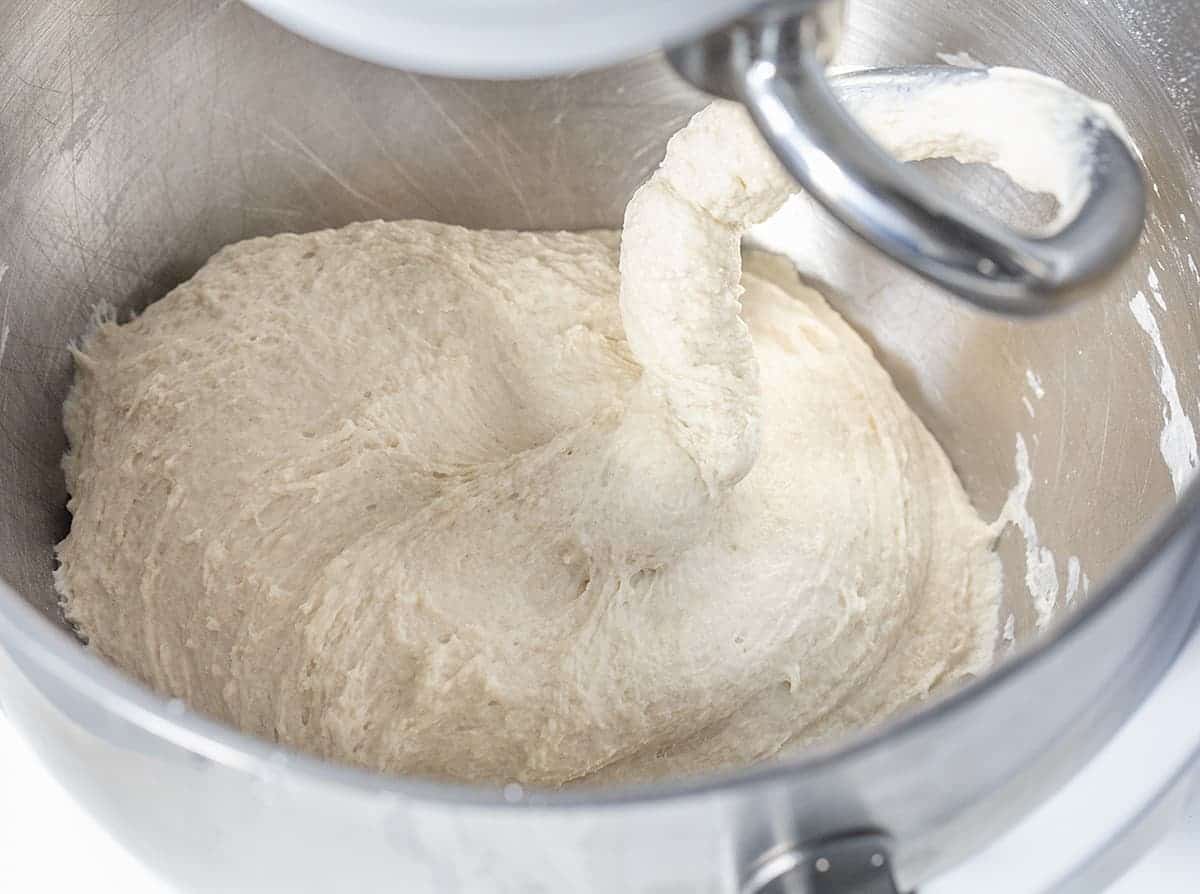
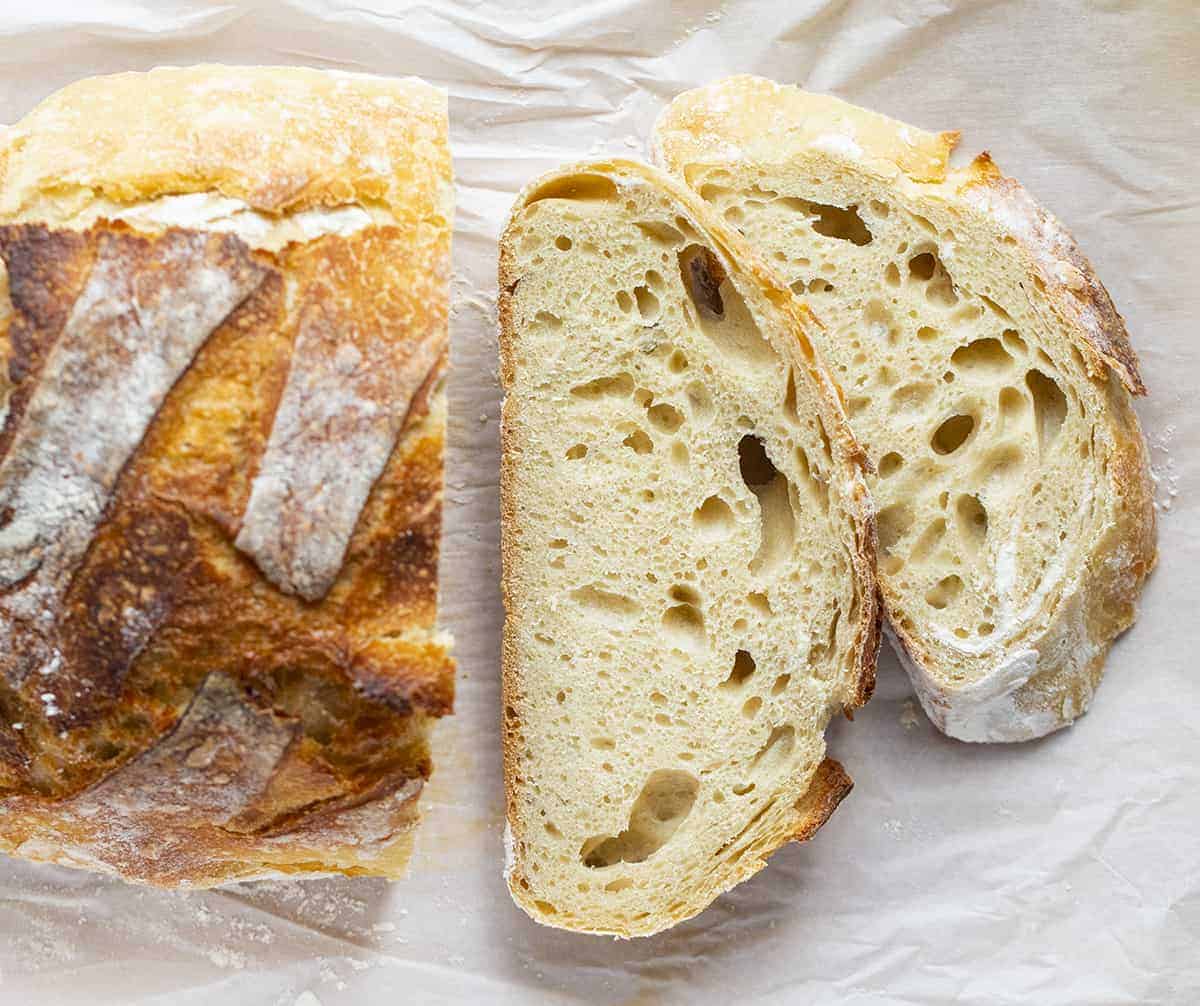

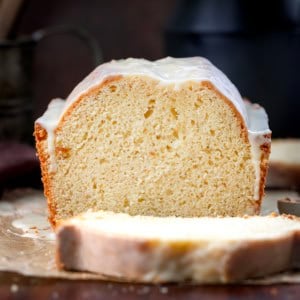









What size dutch oven should be used?
Hi, Elaine! I work with iambaker and am happy to help with questions. A 5-7 quart Dutch oven is an average size and would work for this recipe. I hope this helps, and have a great day!
Maybe someone will explain how to make it starter for this recipe?
I don’t know how to do it and recipe asking for 3/4c I’d starter.
That information is listed above the recipe as well as there is a link to a blog post with DETAILED information on how to make a starter.
The recipe turned out great. Even though it was a tad dense. I think I could have left it to rise a tad bit longer and maybe cooked it a tad bit longe too. Thank you for sharing.
I don’t want to make bread in Dutch oven but regular bread pan. How do I do that?
I’m really pleased with how this turned out! I’ve made a lot of sourdough breads that have ended up heavy, dense and flat despite good flavor. This is the first one I’ve made that was perfect! But, I did apply a few hard lessons learned from my past mistakes. 1. I used 5+ cups of flour to get the right consistency. 2. I didn’t add the salt until after the first rise. I’m not sure why that helps? Something about the salt hindering the action of the wild yeasts? 3. I gave it a final rise of about 2 hours before putting it in the dutch oven and baking. On a cool spring evening, it really helped. The loaf is light, good crust and deliciously sour! Also, this is the first time I’ve baked bread in a dutch oven. I think that is a good call! I will do that from now on. Another note I would make about quantity of flour, especially after reading Tina’s notes, sourdough starters vary greatly! Some people keep theirs quite thin, others, rather thick. This should be factored into any sourdough bread recipe and adjust the amount of flour you need accordingly- the dough will let you know!
I loved this recipe. So easy. So delicious. So soft and chewy,
Amazing recipe, followed it to the letter, the resulting bread turned out perfectly. Thank you x
I’ve made this loaf 3 times. Love it. I’m learning. First time I didn’t bake it quite long enough and it was very heavy and a bit uncooked in middle. I still feel it is a tad bit undercooked, so will try linger next time. Two questions: Do you use freshly fed starter? How long of a final knead and sit time before placing in oven?
Your bio is rather impressive, so I don’t understand why the recipe is not listed in grams. The answer that you have successfully baked the recipe several times with 3 cups of flour, yet your friend used 5 cups is a huge difference. By not listing what you consider to be 3 cups (in grams) would account for why some people are not having success making this recipe. I would like to try it, but I really would need to know how many grams of flour to use. I don’t really feel like experimenting.
It is not listed in grams because I use cups for measurement. As I mentioned, the difference is doughs can be in the hydration of the starter. The truth is that every sourdough bread recipe will be a “test” of sorts because every kitchen is different; different water, different flours, different temperatures, different levels of humidity. I would start with 3 cups and then if your dough is still to wet, you can add more. Sorry if that is not enough detail for you.
Glad I used the 4 cup recipe as it worked perfectly. Added a little more flour for kneading. Yummy too.